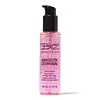What's inside
What's inside
 Key Ingredients
Key Ingredients

No key ingredients
 Benefits
Benefits

 Concerns
Concerns

 Ingredients Side-by-side
Ingredients Side-by-side

Cyclomethicone
EmollientDimethicone
EmollientPhenyl Trimethicone
Skin ConditioningVinyl Dimethicone
Diphenyl Dimethicone
EmollientParfum
MaskingHydrogen Dimethicone
Argania Spinosa Kernel Oil
EmollientGlyceryl Linoleate
EmollientTocopherol
AntioxidantAscorbyl Palmitate
AntioxidantBeta-Sitosterol
Emulsion StabilisingHydrogenated Vegetable Glycerides Citrate
EmollientLecithin
EmollientPropylene Glycol
HumectantSqualene
EmollientCyclopentasiloxane
EmollientDimethicone
EmollientCyclohexasiloxane
EmollientPhenyl Trimethicone
Skin ConditioningParfum
MaskingDimethiconol
EmollientDimethicone Crosspolymer
Emulsion StabilisingBambusa Vulgaris Extract
Skin ConditioningCitrus Grandis Peel Extract
AstringentGlycine Soja Seed Extract
Skin ConditioningLonicera Japonica Flower Extract
Skin ConditioningPropylene Glycol
HumectantBenzyl Benzoate
AntimicrobialBenzyl Salicylate
PerfumingButylphenyl Methylpropional
PerfumingHydroxycitronellol
PerfumingCyclopentasiloxane, Dimethicone, Cyclohexasiloxane, Phenyl Trimethicone, Parfum, Dimethiconol, Dimethicone Crosspolymer, Bambusa Vulgaris Extract, Citrus Grandis Peel Extract, Glycine Soja Seed Extract, Lonicera Japonica Flower Extract, Propylene Glycol, Benzyl Benzoate, Benzyl Salicylate, Butylphenyl Methylpropional, Hydroxycitronellol
Ingredients Explained
These ingredients are found in both products.
Ingredients higher up in an ingredient list are typically present in a larger amount.
Dimethicone is a type of synthetic silicone created from natural materials such as quartz.
What it does:
Dimethicone comes in different viscosities:
Depending on the viscosity, dimethicone has different properties.
Ingredients lists don't always show which type is used, so we recommend reaching out to the brand if you have questions about the viscosity.
This ingredient is unlikely to cause irritation because it does not get absorbed into skin. However, people with silicone allergies should be careful about using this ingredient.
Note: Dimethicone may contribute to pilling. This is because it is not oil or water soluble, so pilling may occur when layered with products. When mixed with heavy oils in a formula, the outcome is also quite greasy.
Learn more about DimethiconeParfum is a catch-all term for an ingredient or more that is used to give a scent to products.
Also called "fragrance", this ingredient can be a blend of hundreds of chemicals or plant oils. This means every product with "fragrance" or "parfum" in the ingredients list is a different mixture.
For instance, Habanolide is a proprietary trade name for a specific aroma chemical. When used as a fragrance ingredient in cosmetics, most aroma chemicals fall under the broad labeling category of “FRAGRANCE” or “PARFUM” according to EU and US regulations.
The term 'parfum' or 'fragrance' is not regulated in many countries. In many cases, it is up to the brand to define this term.
For instance, many brands choose to label themselves as "fragrance-free" because they are not using synthetic fragrances. However, their products may still contain ingredients such as essential oils that are considered a fragrance by INCI standards.
One example is Calendula flower extract. Calendula is an essential oil that still imparts a scent or 'fragrance'.
Depending on the blend, the ingredients in the mixture can cause allergies and sensitivities on the skin. Some ingredients that are known EU allergens include linalool and citronellol.
Parfum can also be used to mask or cover an unpleasant scent.
The bottom line is: not all fragrances/parfum/ingredients are created equally. If you are worried about fragrances, we recommend taking a closer look at an ingredient. And of course, we always recommend speaking with a professional.
Learn more about ParfumPhenyl Trimethicone is a silicon-based polymer. It is derived from silica.
Phenyl Trimethicone is used as an emollient and prevents products from foaming.
As an emollient, it helps trap moisture in the skin. It is considered an occlusive.
Learn more about Phenyl TrimethiconePropylene Glycol is an odorless, colorless liquid. As a humectant, it helps skin retain moisture. It also aids in delivering active ingredients.
Another role of this ingredient is preventing a product from melting or freezing. Propylene glycol also adds antimicrobrial properties to a product, elongating product lifespan.
This ingredient is considered an organic alcohol and commonly added into both cosmetics and foods.
Those with sensitive skin or conditions may develop a rash when using this ingredient.
Learn more about Propylene Glycol